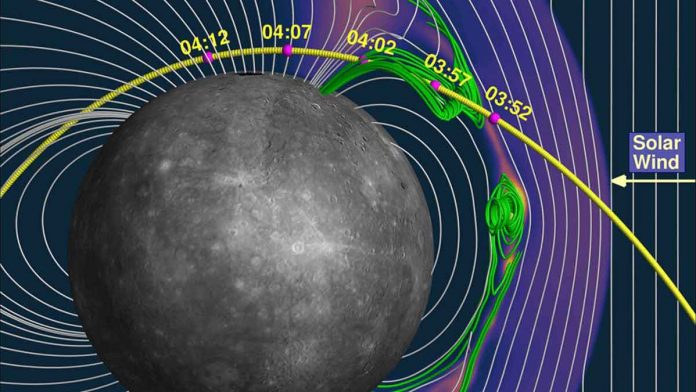Mercury is the only planet in the solar system that is directly affected by the sun’s solar wind. At a distance of barely 1,000 kilometres from Mercury’s surface, the planet’s magnetic field deflects the sun’s stream of electrically charged particles, a location known as the magnetopause.
The solar wind carries the magnetic field lines of the sun, which bend as they hit with those of Mercury. When the conditions are correct, these bent lines break and connect with Mercury’s magnetic lines in a phenomenon known as magnetic reconnection. Particles from the solar wind can penetrate Mercury’s magnetic field during reconnection. Flux transfer events (FTEs) are particle transmissions, and an FTE shower is a burst of FTEs that occur in fast succession.
Sun et al. use data from NASA’s MESSENGER (Mercury Surface, Space Environment, Geochemistry, and Ranging) spacecraft, which orbited Mercury between 2011 and 2015, to investigate the effect of these showers on the planet’s surface in a study published in Journal of Geophysical Research: Space Physics. The onboard ion mass spectrometer, FIPS (Fast Imaging Plasma Spectrometer), recorded the local abundances of sodium group ions, including sodium, magnesium, aluminium, and silicon ions, as the spacecraft moved through Mercury’s magnetopause and reached the surface. An onboard magnetometer measured the local magnetic environment at the same time. This situation occurred 3,748 times during MESSENGER’s orbital mission, with half of them involving the observation of an FTE shower.
The abundance of sodium group ions in Mercury’s atmosphere is statistically analysed by the authors. They discover that during approaches that coincide with an FTE shower, the abundance of sodium group ions in the atmosphere is around 50% higher than during non-FTE shower periods. The scientists find that sputtering from the solar wind is the most likely explanation after studying many different pathways.
According to the authors, these MESSENGER observations are an important indicator of the dynamism of Mercury’s thin atmosphere. In addition, when the joint European-Japanese mission BepiColombo arrives at Mercury in early 2026, more information is expected. The mission is made up of two spacecraft, one for Mercury and the other for its magnetosphere. They should be able to provide unparalleled detail on FTE-induced solar wind sputtering if they work together.

